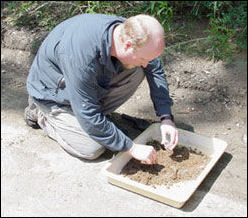
The main emphasis of my research is in population and evolutionary genetics. The major long-term goal of my research is to contribute to the understanding of the evolutionary, ecological, and historical processes responsible for the patterns of diversity observed in nature, a central concern to evolutionary biology.
Current areas of research include: population and evolutionary genetics of introduced and native fire ants (including molecular systematics of fire ants), functional genomics, and the evolutionary interactions of Wolbachia endosymbionts and their insect hosts.
Population and evolutionary genetics of introduced and native fire ants
Population genetics of the two fire ant species Solenopsis invicta and S. richteri
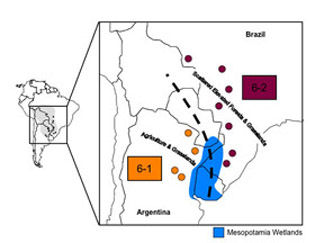
Assess large-scale phylogeographic patterns of variation within native S. invicta using mtDNA and nuclear DNA markers.
Identify the native source population(s) for S. invicta introduced into the U.S.A using multiple genetic markers of different types (i.e., allozymes, microsatellites, mitochondrial DNA sequences, nuclear DNA sequences).
Reconstruct global invasion history of S. invicta.
Genetic structure of a hybrid zone formed between the two introduced fire ant species Solenopsis invicta and S. richteri in the USA
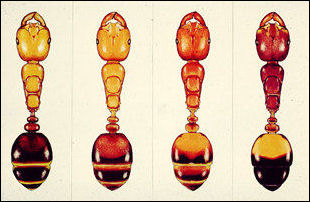
Determine the fitness of various hybrid genotypes relative to each parental species, to uncover the genetic
differences responsible for reproductive isolation between the two species, and to follow the evolution of this
hybrid zone over time.
Determine what factors have led to the breakdown of reproductive isolation between the two species upon their
introduction into the USA (or, conversely, what factors prevent hybridization in South America)? We are
conducting comparative ecological and genetic studies of the two species in the USA and South America in an effort
to answer this question. We also are studying the possible role of Wolbachia in reproductive isolation
between these two species.
Molecular systematic revision of the Solenopsis saevissima species-group, which includes S. invicta
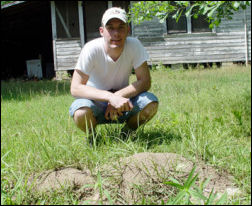
Infer species relationships and delimit species boundaries using both mtDNA and nuclear DNA sequences. Examination
of the patterns of genetic variation at higher levels is a logical extension of studies examining patterns of
intraspecific genetic variation. Indeed, the clearest picture of evolutionary processes within fire ants requires
analyses at multiple levels. These data will help clarify concepts of species-level variation and, in so doing,
will reveal how many species constitute the group, elucidate the native ranges of these species, and confirm the
identity and source populations of introduced species. More generally, the phylogenetic hypotheses we generate
will serve as the evolutionary framework for a variety of comparative physiological, behavioral, and ecological
studies of fire ants.
Functional genomics
One exciting recent development in my area is the generation of an EST library and microarray for the fire ant
S. invicta. These new genetic tools will allow us to address some of the above questions in much finer detail than ever thought possible and have opened the door for new areas of research in my laboratory. Examples include:
- Comparative genetic studies of fire ants seeking to identify portions of the genome involved in the development of reproductive isolation in order to understand the causes of speciation in this ecologically and economically important group of ants. These data also will be especially useful in illuminating the factors promoting hybridization between S. invicta and S. richteri (see above). These two species do not normally hybridize where their native South American ranges overlap, so insights into the phenomenon in the U.S.A. may provide important clues as to why invasive species or those whose habitats have been modified by humans frequently hybridize, a major concern in conservation biology.
Use of microarrays to determine how admixture of two complex genomes affects gene expression and, ultimately, the fitness of hybrid fire ants in the USA. These data also will contribute to our understanding of the epistatic gene networks that underlie many fundamental evolutionary processes as well as elucidate regulatory gene evolution and genomic coadaptation.
- Discovery of genes differentially expressed between parasite-challenged and unchallenged fire ants. To accomplish this, we are comparing gene expression profiles between fire ants infected with a microsporidan parasite and uninfected fire ants. As the first and only attempt to compare large-scale gene expression patterns in parasite-challenged and unchallenged fire ants, the proposed research represents a major step forward in promoting biological control of this multi-billion dollar invasive pest. The proposed research is of paramount important for identifying candidate genes that respond to infection by pathogens as well as for increasing our understanding of pathogenesis in fire ants. Knowledge of patterns of gene expression may lead not only to novel methods for controlling fire ant colonies (i.e., by artificially altering gene expression of master regulators to increase susceptibility to pathogens) but also will provide new methods for detecting potential pathogens.
- Large-scale cDNA sequencing project of fire ants in an effort to develop numerous markers for genetic mapping and QTL analyses. Also, this large number of new molecular markers can be used to reconstruct in sharp detail the evolutionary and demographic history of S. invicta, which in turn will facilitate reconstruction of the invasion history of this pest insect in the U.S.A. and other parts of the world. The evolutionary genetics of invasive species is a topic of enormous current interest because invasive organisms pose major threats to biodiversity, ecosystem integrity, agriculture, fisheries, and public health. Recent studies suggest that changes in variation at small numbers of genes can have profound impacts on colonization ability and invasion success, so genomic approaches involving analyses of gene expression, epistasis, and gene rearrangements in invasive species may reveal much about how such genes act. Solenopsis invicta is an excellent candidate for such an approach because of its stunning success as an invader and the well documented genetic and ecological changes that have taken place in the invasive populations. Combined with the extensive knowledge of the natural history of S. invicta, we plan to expand our research into ecological and evolutionary functional genomics, an enterprise that focuses on identifying polymorphisms segregating at genes that affect ecological and evolutionary success in natural environments and that attempts to elucidate the functional consequences of such variation.
Evolutionary interactions of Wolbachia microbes and their insect hosts
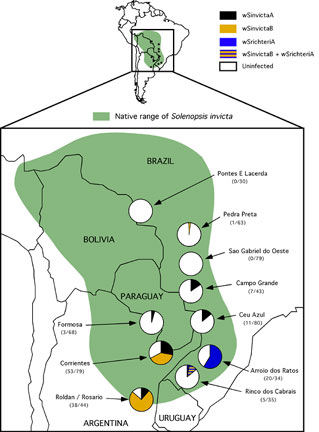 Wolbachia
Wolbachia are maternally-transmitted alpha-proteobacteria that infect primarily the reproductive tissues of many arthropods. Recent studies suggest that up to twenty percent of insect species may be infected with
Wolbachia and that these microorganisms may be important factors preventing gene exchange between some closely-related insect species.
Wolbachia have evolved a number of mechanisms by which to enhance their transmission while still having adverse effects on their hosts. In some insect species,
Wolbachia enhance their transmission by causing parthenogenetic reproduction, ensuring that these endosymbionts are passed on to all descendants of infected individuals. In some other insects,
Wolbachia are male killers: infected males are produced, but these die at a young stage. This male-killing strategy can enhance
Wolbachia transmission through females when eggs are laid in clutches and when the presence of males reduces the fitness of their sisters (e.g., through competition for food resources or cannibalism). The most commonly described phenotypic effect of
Wolbachia in
Drosophila is unidirectional cytoplasmic incompatibility (CI), which occurs when an uninfected female mates with an infected male. Such matings generally result in few or no progeny because of abortive karyogamy.
Ongoing and future projects involving
Wolbachia include:
- Determine whether Wolbachia endosymbionts are an important postmating barrier to gene flow between the two fire ants Solenopsis invicta and Solenopsis richteri in their native South American ranges.
- Study the effects of Wolbachia on host mtDNA population genetics and evolution. Because both Wolbachia and mtDNA genomes occur in the cytoplasm and are thus co-transmitted, the spread of Wolbachia within a population is predicted to have specific effects on the population genetics and molecular evolution of host mitochondrial DNA. Our experiments will address the long-term dynamics of mitochondrial evolution in several host insect species. These data will be relevant to determining whether Wolbachia can drive maternally inherited genes into a population as well as whether the spread of Wolbachia results in the concomitant spread of slightly deleterious mutations within species, which in turn may lower the fitness of the pest insect hosts.

- Infer the evolutionary history of Wolbachia infections in Solenopsis spp. We currently are focusing on S. invicta, which harbors at least three Wolbachia variants.
-
 Fitness effects of Wolbachia on the fire ant S. invicta. We currently are conducting a series of studies to determine what phenotypic effects, if any, Wolbachia induce in S. invicta. Determining whether these microbes have significant fitness effects on fire ants (either directly or by cytoplasmic incompatibility) is important for evaluating the potential of incorporating Wolbachia into biological control programs aimed at suppressing introduced fire ant populations.
Fitness effects of Wolbachia on the fire ant S. invicta. We currently are conducting a series of studies to determine what phenotypic effects, if any, Wolbachia induce in S. invicta. Determining whether these microbes have significant fitness effects on fire ants (either directly or by cytoplasmic incompatibility) is important for evaluating the potential of incorporating Wolbachia into biological control programs aimed at suppressing introduced fire ant populations.

